8 stories on how computer simulation helped companies to improve Induction Heating in 2020

The year 2020 was tremendously challenging for businesses in the automotive and machinery industries, but some open-minded companies managed to become winners and increased efficiency incrementally. Adoption of computer-aided engineering (CAE), or so-called simulation, for tooling design and optimization of production processes like induction heating, pre-heating, and hardening is a good example of such winning strategies.
For a long time, CAE software has been perceived as a very expensive investment to be used in the corporate R&D centers only. A European startup CENOS has made induction heating process simulation accessible for every engineer with its new-generation simulation software for induction heating and hardening applications, which has made simulation easy, affordable and not limited to R&D centers only – now accessible to production plant and smaller manufacturing company engineers with no or little previous experience in simulation.
The software company CENOS managed to grow fast throughout this COVID-19 year and almost tripled its revenue in 2020. That proves the demand for easy-to-use simulation as a way to increase productivity and overall efficiency in the situation of pandemic constraints.
Here are 8 stories from CENOS simulation software users in 3 different continents, all enjoying tremendous benefits provided by the adoption of induction heating tooling design and process simulation: A. Production plants – induction heating equipment end-users (ThyssenKrupp Presta Schönebeck, GKN Driveline Celaya, Netzsch do Brasil and Volkswagen Group Services), B. Induction heating equipment manufacturers and service providers (GH Induction, SMS Elotherm), C. German ‘Mittelstand’ – small shops for induction heating design and tooling (COBES GmbH, Lötec GmbH).
A. Production plants – end-users of induction hardening technology
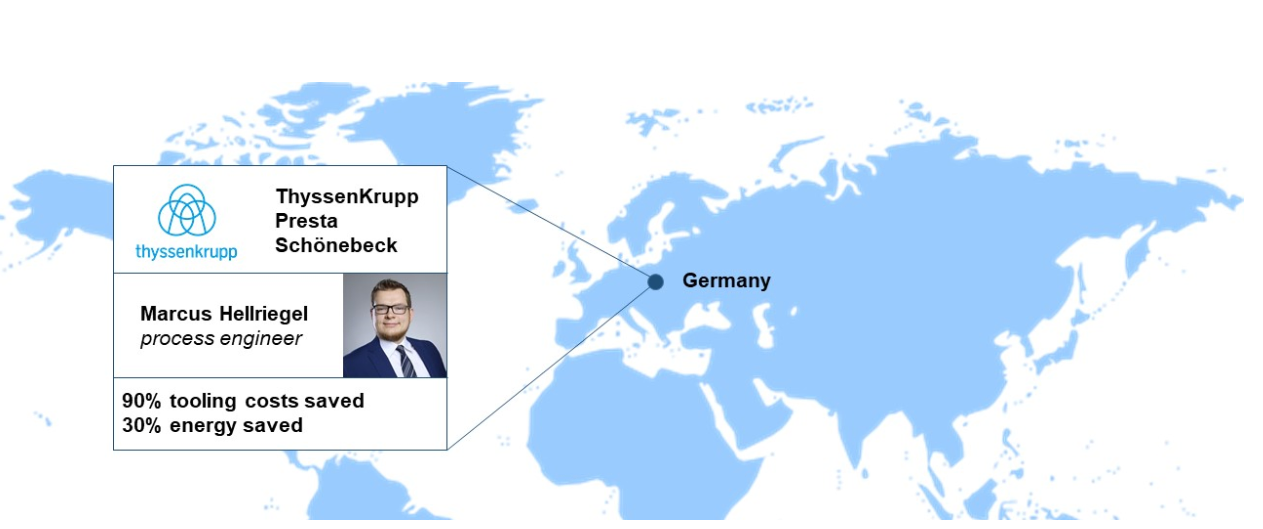
(1) ThyssenKrupp Presta Schönebeck saved 90% on tooling and 30% on energy
Marcus Hellriegel – an engineer at ThyssenKrupp Presta in Schönebeck (Elbe) near Magdeburg in Germany, managed to design a new induction coil for hardening of the ball track inside a ball nut (a steering system part) which reduced the tooling costs per part by 90% and energy consumed by 30%, which resulted in seven-digit savings for the company per year. Marcus was able to complete the new design just in a couple of months in a very cost-efficient way by using CENOS Induction Heating simulation software and 3D-printing technology.
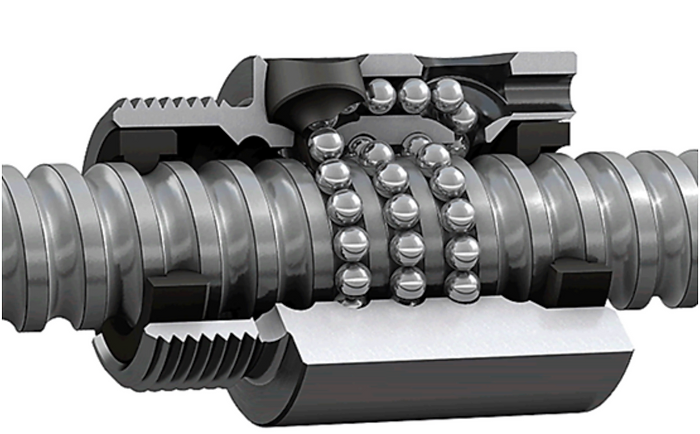
The problem Marcus was trying to solve was a very short lifetime of the so-called hairpin-type coil used for hardening of the inner ball track. Thus, Marcus’ primary goal was to improve the coil design to achieve a longer lifetime and lower production costs. It took about 10 design iterations to come up with the new coil shape, which demonstrated excellent results in tests. Now, ThyssenKrupp is pending the patent for this brand new coil design. For this job, Marcus decided to use simulation software to test design candidates virtually and 3D print the final coil. Here are the economics behind this decision:

Thus, if things were done the traditional way by ordering conventionally manufactured coils from a supplier, 10 design & prototyping iterations would take more than a half-year (taking into account the time for design, tests and result analysis) and would cost around EUR 60,000 just for different coil design version trials. For such a sophisticated coil type, one could save time by ordering 3D printed coil prototypes from an additive manufacturing supplier but still it would take 3-4 months and cost around EUR 10,000.
Marcus decided to learn the simulation software to be able doing all design iterations by means of the computer simulation and 3D-print the final design candidate for the real-life test. From all simulation software available in the market, Marcus chose CENOS because it is focused on induction heating and ensures unmatched speed of learning due to its straight-to-the-point interface for induction tasks. So, the new design of the coil was completed in a couple of months. The use of simulation unleashed the engineering talent of the designer allowing to test even the craziest ideas at no extra cost – everything was tested virtually on a PC and eventually fabricated with the help of 3D printing.
When the new coil was 3D-printed, it was time for the lab tests. It was surprising that the test demonstrated up to 30% of energy saving for the newly-designed coil compared to the old one. The reason for this dramatic increase of energy efficiency is due to the fact that the 3D-printed coil has no soldering joints. This particular inductor type, if conventionally manufactured, has up to 20 soldering joints – each joint increases overall coil resistance that results in a higher energy consumption. A 3D-printed coil on the contrary has zero solderings – thus, lower electric resistance.
While the main goal of the project was to create a new design for the coil that will not break so often, tremendous savings came from lowered production costs and increased energy efficiency of the coil. The coil efficiency was enabled by 3D-printing technology, and simulation software made the design process extremely efficient. That all, multiplied by the engineering talent of Marcus Hellriegel, led to an exceptional return on investment (ROI) for the combination of CENOS simulation software (EUR 7,800 per year) and the 3D-printed part (EUR 1,000 per coil) which resulted in saving 90% on tooling and 30% on energy costs.
(2) GKN Driveline Celaya increased overall equipment efficiency (OEE) for a CV joint hardening line by 9%
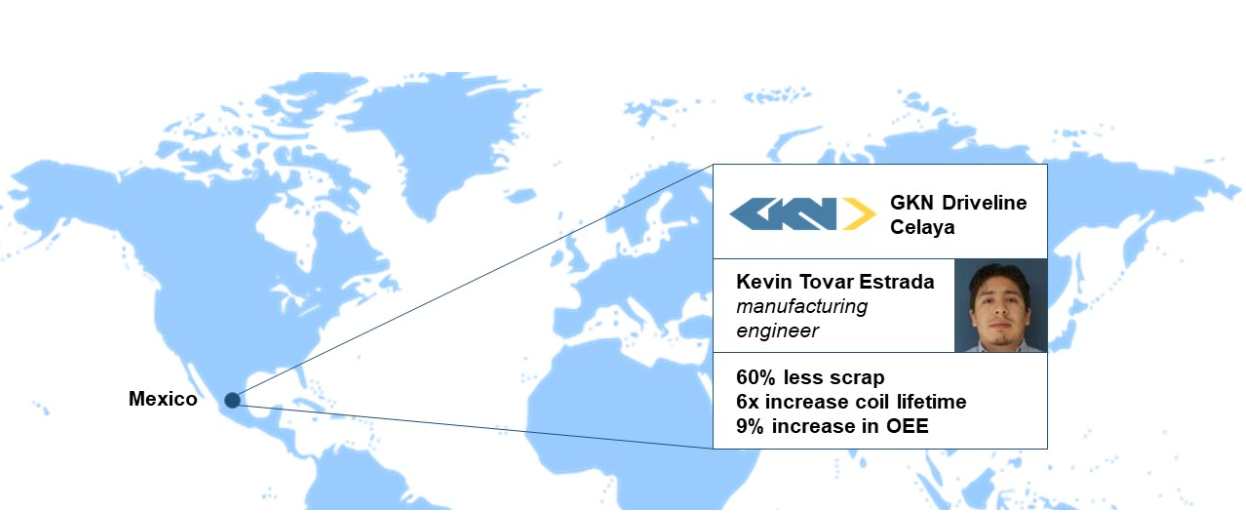
Kevin Tovar Estrada – a manufacturing engineer at GKN Driveline Celaya in Mexico, supervises induction hardening lines at the plant. He created a hardening “cookbook” – an algorithmic instruction for a machine operator to troubleshoot wrong hardening results. For example, the operator can change the gap size between a part and an inductor to correct the hardening profile when there is a slight change in part design, or some other parameters changes – quenching liquid, outside temperature, steel, etc. The operator makes an inspection of the hardening profile by cutting the part. If there is a deviation from the desired profile, he/she adjusts the parameters according to the “cookbook”, which ensures a reliable result with less scrap.
Simulation software helped Kevin to create such a cookbook 60% faster than in the traditional way with physical experiments. For a CV joint shaft hardening, the simulation approach also saved about 14 parts, which would be otherwise wasted. As a result, the production process runs with 60% less scrap.
Kevin did comparison tests to choose the right simulation software. CENOS – an induction heating specialized simulation software, demonstrated exceptionally good results: case preparation (setting of geometry and operational parameters) was 10 times faster than with other software, while calculation time was the same or faster. There was also a handy function that simplified the model by using constant magnetic permeability for faster calculation – the feature which was absent in other software. Total time for simulation analysis of a CV joint shaft hardening took 7.5 hours with CENOS.
To be sure about the results, Kevin compared the simulated hardening profile with the cross-section cut of the real part, the software had prediction accuracy of 93.8%. Then, Kevin redesigned the coil for CV joint hardening based on the simulation. He altered the position of flux concentrators and found a better design which eliminated local overheating. Old coil design failed and started leaking after 20,000 shots, while the redesigned coil is still running after 122,000 shots – more than five-fold improvement of the coil lifetime.
By summing all of the benefits of the simulation software adoption in the engineering routine of the plant, Kevin got a 9% increase of the overall equipment efficiency (OEE).
(3) Netzsch do Brasil reverse engineered hidden operational parameters of their induction machines for R&D

Klaus Heizinger – the head of research and development at hydraulic pump producer Netzsch do Brasil, is responsible for the production process R&D, efficient hardening of parts is an important part of his work. The company purchased an induction hardening machine a couple of years ago. Multiple things had changed since then – the design of the parts, the steel used, etc., as Netzsch was constantly working to improve their products and manufacturing processes.
When trying to adjust the hardening process, Klaus and his colleagues were struggling to get satisfactory results. The main reason was very limited control over the hardening machine. “The operational interface gave us almost no quantitative data of the process”, explained Klaus. “For example, there are just three options for the frequency: high frequency, medium frequency, and low frequency, without any information of what are the absolute values of those frequencies. So, the engineers were wasting parts and time by doing numerous experiments, but still were struggling to get good results in many cases” Klaus admitted.

Then, Klaus decided to purchase a specialized induction heating simulation software with an idea to support reverse engineering of the machine settings for a better understanding of the process. That turned out to be a successful approach. “Now, we know much better what and how our machine can do”, proudly reported Klaus, “thus, we can work on the process improvements with confidence, experiment with new materials for parts. CENOS significantly improves R&D at our plants.”
(4) Volkswagen Group Services achieves fivefold productivity increase of power steering rack mounting production
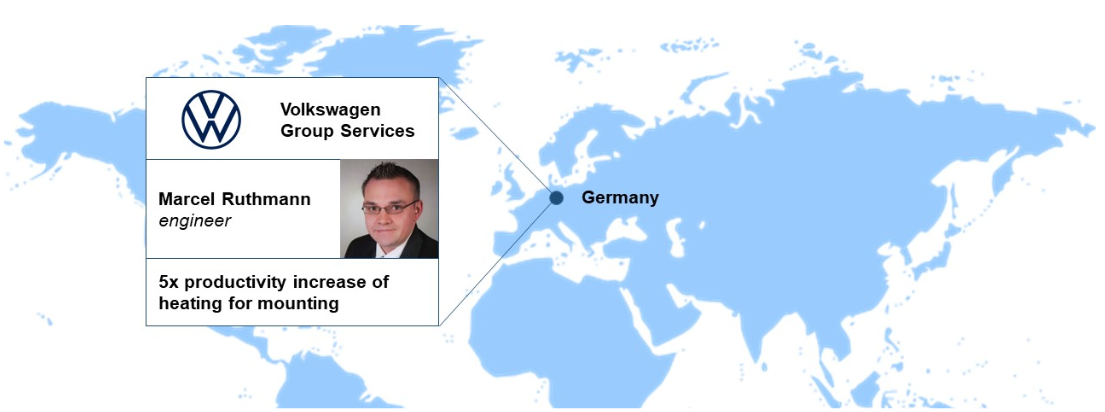
Marcel Ruthmann – a young engineer at Volkswagen Group Services in Braunschweig, Germany, began using simulation to increase the efficiency of induction heating in the production processes of the company. While the majority of his successful projects will remain hidden for external observers, there is one worth a mention.
By means of simulation with CENOS software and working together with Fabian Bauer – an engineer at Volkswagen in Wolfsburg, Marcel reduced the induction heating time for the mounting of the power steering rack about 5 times – from 9 seconds down to 2 seconds. Thus, the productivity of power steering parts manufacturing line is almost 5 times higher now
B. Induction heating equipment manufacturers and service providers
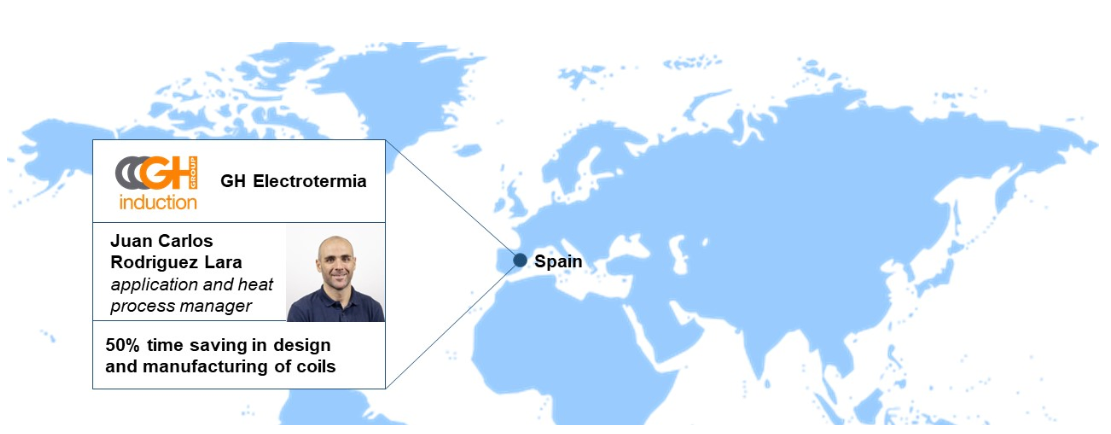
(5) GH Induction saved 50% on the design and manufacturing time of induction coils for their customers
Juan Carlos Rodriguez Lara – an application and process manager at GH Electrotermia, the headquarter of GH Induction Group in Valencia, Spain, oversees the development of customer projects like induction coil design. The company provides a unique service offering the design and 3D printing of inductors (3Dinductors.com) utilizing electron beam melting (EBM) technology. Combining this technology with CENOS simulation GH shortened the time to discover and demonstrate coil design improvements to their customers and currently provides the utmost reliability and maximum performance of the inductors.
With one of the latest cases, Juan Carlos’ engineers managed to achieve 50% savings on the design and production time which led to surprising their customer with exceptionally fast delivery of a top-quality inductor. The customer’s request was to redesign the coil to meet the change in the hardening profile specification for wheel hub production the customer did. So, GH Electrotermia needed to adapt the inductor design quickly to meet the new requirements.
First, the heating pattern was simulated for the customer’s original inductor design. Based on induction heating experience it was pretty clear which parameters had to be modified in the coil to meet the new specifications. A couple of simulations later the design was nailed – way faster than producing prototype inductors and testing them in a lab. Since GH’s 3D printing technology allows absolute freedom of external and internal design (cooling improvement, hot spot elimination, section strength, etc.), the new better design was proposed by the engineering team of GH and fulfilled by 3D printing in a few hours.
(6) SMS Elotherm gets desired hardening profiles with the first inductor design built

Judith Levermann – a process development engineer at SMS Elotherm in Remscheid, Germany, is responsible for the design of inductors and hardening processes for sophisticated customer cases. “With CENOS, we are able to develop inductors for new hardening cases without large expenses and set up more advanced heat treatment approaches without multiple lab trials,” Judith explained.

Judith agreed to share two examples of the design she performed: ring inductor for a gear ring (the upper left image) and pre-heating followed by hardening of another gear with scanning inductor (the lower right image). “We had many ideas on how to harden the tooth area of the gear ring. However, we wanted to try out different options without creating large expenses but also meet the hardening zone requirements with the first inductor built,” Judith explained the motivation behind the use of simulation. Without any experiments and in a very short time, the process department was able to test all ideas and selected the best performing one. When the inductor was built, Judith ran the physical test and found the zone affected by hardening matched well with the predicted zone by the 3D model in CENOS.
C. German Mittelstand (small companies) for induction heating design and tooling
The last two stories are from small German companies, so-called Mittelstand, which work as induction heating tooling shops and hold a huge number of orders from the automotive industry due to decades of experience they have in the engineering of induction projects. The induction-heating-specialized simulation software CENOS helps them by supporting their experience with bullet-proof evidence that attracts more orders and demonstrates sustainably good results even upon the change of engineer’s generations.
(7) “We are a small induction heating company with more than 30 years of experience in designing excellent induction systems,”
told Cay-Oliver Bartsch – the owner & director of COBES in Ettenheim, north from Freiburg. “Nevertheless, when we approach new customers, they still want to be 100% confident in our work. Simulation helps us to visualize results, ensure customers, and eliminate friction in getting orders.”
(8) “Already in the first month of using CENOS, we have been able to close several coil design projects,”
proudly told Lucas Tebes – an engineer at Lötec in Rheinmünster south from Karlsruhe, the son of the founder of the company Harald Dieter Tebes. “The results of the simulation have been spot on and fully match real-life cases. CENOS has helped us a great deal,” Lucas adds.
From cost and time savings in tooling and process design to less friction in customer acquisition – these are the benefits of the fourth industrial revolution, provided by computer aided engineering which is becoming more and more accessible and affordable for small and medium-sized companies and engineers with no previous simulation experience. We encourage you to try out simulation and see for yourself!


